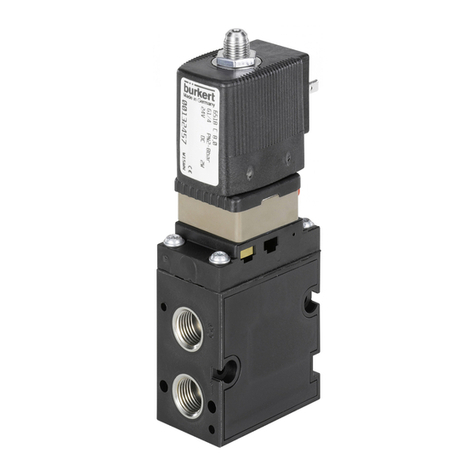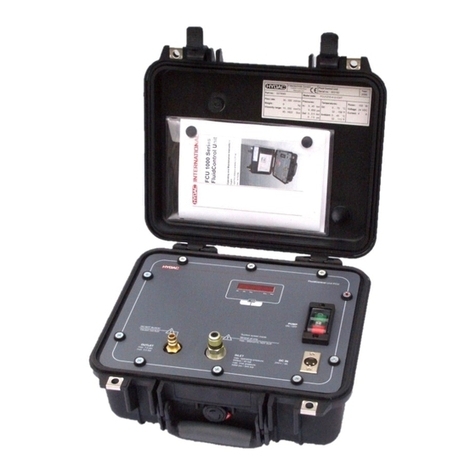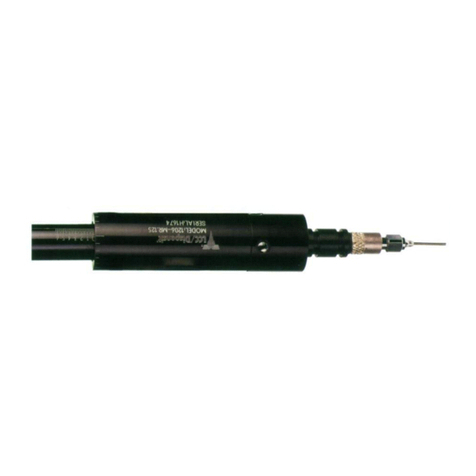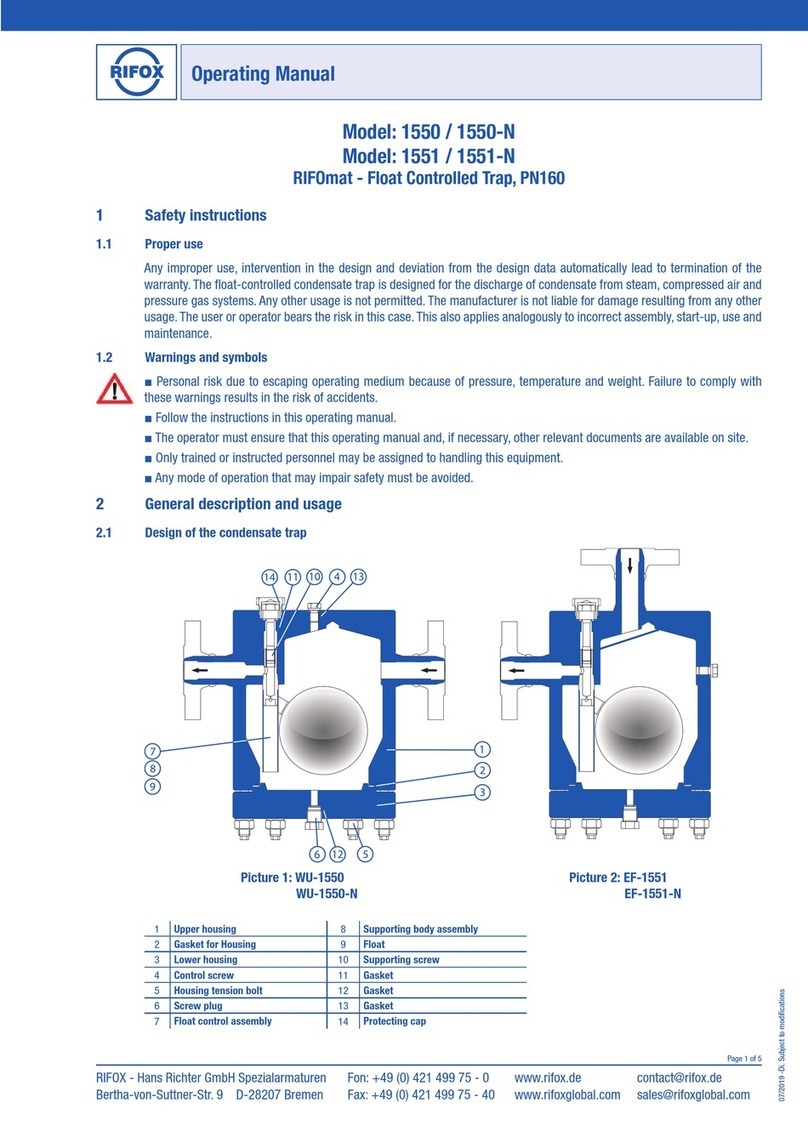clatters GARDEN LISTENER User manual

manual

1
GARDEN LISTENER
The Garden Listener Eurorack module is the eurorack version of the
Pocket Garden Listener. Like his little brother: it detects surface variations
in current and transforms them into MIDI notes. Its behavior can be
tamed through the one-knob menu from which you can choose and
modify: probes’ sensitivity (making it more or less sensitive to current
variations), scale (chromatic, major, minor, indian and arabic), MIDI
channel (from 1 up to 16) and LEDs’ brightness.
In addition, unlike the Pocket Garden Listener, it also converts those MIDI
notes into analogue voltages, generating trigger, gate and CV signals (0 -
5V). The CV output behavior can be modied via an octave selector which
acts as a “CV equalizer” from which you can choose to generate CV only
if the respective MIDI note lies within a certain octave range.
The MIDI output allows you to take advantage of the sound of either any
synthesizer equipped with a MIDI port or any VST in your DAW.
Technical specs:
Material
FR4 panel
Current draw
+12V: 24mA
-12V: 20mA
+5V: 0mA;
Dimensions
Width: 8HP
Depth: 22.6mm

2
Introduction to
detection and
conversion of electrical
surface activities
INDEX

3
01
Every living being shows electrical activities on its surface as a sign of
its vitality: electrical signals can be captured from human skin as a result
of muscles and neurons’ activities and can be highly altered by skin’s
moisturization; also plants show electrical activities on their leaves as a
consequence of their metabolic processes.
Being able to capture those signals and use them for musical purposes
is the nal intention of our rst eurorack module. Having the possibility to
nally merge electronics and physiology into a musical instrument which
shows that these two scientic elds can be actually reduced to the same
concept: electrons running around and producing a variety to dierent
eects because of their movement.
Biological activity can be synthesized to the concept of electrons leaving
and joining new atmos with the result of creating molecular instability and,
thus, movement. Electronic music is all about this: electrons, current,
endlessly moving from one point to another producing oscillations: sound.
The Garden Listener Eurorack is a module based on the Midi Sprout
technology that allows you to take advantage of those electrons’
movements inside living beings. It’s not about listening to their internal
motion; it’s about capturing surface variations in conductivity caused by
that motion and transforming them into something more useful from the
musical point of view.
This module is not a sound source, and not even a LFO, it’s meant to be a
bridge between the physiology world and the music one: it detects
variations in conductivity through the use of probes and converts them
into MIDI notes and CV signals.
The module comes with a set of white snap-on probes and a pair of
reusable adhesive pad electrodes, but you can actually use any kind of
probes depending on your needs (e.g. alligator clips, etc..).
Please remember that the module needs calibration in order to function
properly (see section 5 Calibration).
1. Introduction to detection and conversion of
electrical surface activities
INTRODUCTION
INTRODUCTION

4
You can think about the Garden Listener as a two vertical blocks module
separated by the gold leaf’s pattern. The rst and graphically superior
block deals with electrical activities detection and MIDI data:
conductivity variations are detected by the Probes Input (A) and
converted into MIDI notes which then follow 2 dierent paths; they exit
through the MIDI Output (B) and at the same time ow into the second
block which lies on the bottom of the module and has the task of
converting those MIDI notes into Trigger, Gate and CV signals (C).
Each block can be manipulated and tamed through various controls on
the front panel:
Action section: allows
you to manipulate the
incoming electrical
activities. This is a
one-knob menu
accessible through the
Action Push Button.
Here you can set the
probes sensitivity, musical
scale, midi channel and
LEDs’ brightness (see
section 3 First block: MIDI
notes manipulation and
light settings);
Octave selector: allows
you to divide the cv signals
into categories based on
the octave they belong
to, actually acting like a
CV-equalizer (see section
4 Second block: trigger,
gate and CV tamer);
Trigger and Gate
controls: you can
set a dierent peak
(0 - 5V) of these two
parameters via the
two potentiometers,
actually acting like
dry/wet controls
when controlling
noises and eects;
FRONT PANEL
02
2. Front Panel: the two block and their controls

5
Once you are on the desired page, press the Action Push Button, the
corresponding LED will now blink faster, indicating you just entered that
page. Now you’re able to modify the parameter associated to that page
by moving the Action Potentiometer.
More specically:
Page one, probes sensitivity: move the Action
Potentiometer to modify the probes sensitivity; the LED’s
brightness will be proportionate to the new sensitivity
amount. By moving the potentiometer counterclockwise,
probes sensitivity decreases and thus threshold increases;
the module will now be less sensitive to small changes in
conductivity. Move the Action Potentiometer clockwise to
increase probes sensitivity and thus decrease the threshold;
the module will now be more sensitive to small changes in
conductivity;
Page one, pink LED:
set probes sensitivity;
Page three, orange LED:
set MIDI channel;
Page two, turquoise LED:
set notes’ scale;
Page four, purple LED:
set LEDs’ brightness;
03
FIRST BLOCK
3. First block: MIDI notes manipulation and light
settings
By default the Garden Listener will detect any conductivity variation and
convert it into a note of the chromatic scale with an octave range varying
from C-1 to C8: the higher the change in conductivity with respect to a
certain threshold, the higher in tone the note. This behavior can be
modied in many dierent ways through the Action section which allows
you to enter the main menu of the module.
Press the Action Push Button (D) to enter the menu: depending on
the position of the Action Potentiometer (E), one of the ve colored LEDs
will start blinking, indicating you in which page of the menu you are about
to enter (remember that the menu has a shout-down time of 5 seconds:
when entered the menu, if no further action is taken within 5 seconds, the
Garden Listener will close the menu by itself). You can use the Action
Potentiometer to scroll through the four dierent pages of the menu:

6
1.1. 2.2. 3.3. 5.5.
6.6. 7.7. 8.8. 9.9. 10.10.
11.11. 12.12. 13.13. 14.14. 15.15.
16.16.
4.4.
Page two, notes’ scale: move the potentiometer to scroll through the
various scales available. Each scale is associated with a dierent color-code:
Please note that all the mentioned scales are C scales
Default settings:
• Threshold: medium (potentiometer at 12 o’clock);
• Scale: chromatic;
• MIDI channel: 1;
• LEDs brightness: high (potentiometer at 3 o’clock);
Page four, LEDs brightness: this page is more about aesthetics and
ambiance. The Garden Listener has extra bright LEDs. Moving the Action
Potentiometer will modify LEDs’ brightness, you can set your desired light
intensity by looking at the purple LED’s brightness being aected by the
potentiometer movement. If you like to perform with your modular synth in
the darkness, set the brightness to maximum and enjoy the light show!
Once you’re done with your settings, press again the Action Push Button to exit the menu.
Please remember that all these settings cannot be saved and the Garden Listener will revert
to its default settings when it’s turned on again in the future.
Chromatic scaleChromatic scale Major scaleMajor scale Minor scaleMinor scale Indian scaleIndian scale Arabic scaleArabic scale
Page three, MIDI channel: you can set the module to dierent MIDI channels, from channel
1 up to channel 16, by entering this page.
By default, your module is on channel 1. On this page, the ve LEDs act as bits and they will
have value 1 when lighted on and 0 when lighted o; by moving the Action Potentiometer,
the Garden Listener will display a binary number which will show you the MIDI channel.
Don’t worry! We know binary numbers are not an easy task for everyone, so here is a table
for you of each MIDI channel and the corresponding color-code.

7
4. Second block: trigger, gate and CV tamer
This block has the task of generating trigger, gate and CV signals from the
incoming MIDI data. Every time a MIDI note reaches this section, a pulse
is sent to the trigger output and a stepped pulse to the gate output.
Both trigger and gate amplitudes can be modulated from 0V to 5V via the
two dedicated potentiometers, acting either like standard trigger and gate
outputs or dry/wet controls for external noises and eects.
CV signals can be ltered and tamed via the Octave selector which allows
them to exit only if they belong to certain octave ranges.
CV LED’s brightness depends on the output voltage. Even if the LED
doesn’t blink, you may have low voltages coming out.
You can think about the Octave selector like a 3-band EQ:
04
SECOND BLOCK
Switch A lters the CV
signals making sure that
only signals generated
by notes belonging to
the octaves C-1 - C1
pass through;
Switch B lters the CV
signals making sure that
only signals generated
by notes belonging to
the octaves C2 - C5
pass through;
Switch C lters the CV
signals making sure that
only signals generated
by notes belonging to
the octaves C6 - C8 pass through;
The following combinations are also available: Switch A + B (from C-1
to C3) and Switch B + C (from C4 to C8). All the remaining
combinations (all the switches on, o, and A + C) deactivate
the EQ and allow all the CV signals to pass through.
Once you set up the switches, press the Save button to
actually activate the Octave selector; a small light show will
be performed indicating that the preset has been saved.
OCTAVE

8
5. Calibration
The Garden Listener needs to be calibrated in order to function properly.
A good calibration ensures the right conversion of MIDI notes into CV signals.
CALIBRATION
05
CALIBRATIONCALIBRATION
Keep pressed the encoder (F) on the back of the module while
powering up your system until a small LED indicated by a circle on the
PCB will start ashing, release the encoder and the LED will stay on: this
indicates that you have just entered the calibration mode.
Use a multimeter to measure the Vout on the two pin headers located on
the back of the module, turn the encoder until you reach exactly 3V;
the more digits your device has, the more accurate the calibration will be.
If you do not have a multimeter, patch the Garden Listener CV out to one
of your oscillators, use a tuner and turn the encoder until you reach a
perfect C2.
Press the encoder again to exit the calibration mode.
Now your Garden Listener is ready. Leave those LFOs alone, and let
any living conductive being modulate your signals!



11
GARDEN LISTENER
Il Garden Listener Eurorack è la versione eurorack del Pocket Garden
Listener. Come il suo fratellino, rileva variazioni superciali di conducibilità
e le trasforma in note MIDI.
Il suo comportamento può essere controllato tramite un menù da cui è
possibile modicare: sensibilità delle sonde (rendendolo più o meno
sensibile a cambiamenti di conducibilità), scala musicale (cromatica,
maggiore, minore, indiana e araba), canale midi (da 1 a 16) e
luminosità dei LED.
In più, al contrario del Pocket Garden Listener, converte le note MIDI
generate in segnali analogici, generando trigger, gate e CV (0 - 5V).
Il comportamento dell’uscita CV può essere modicato tramite un
Selettore di Ottave che agisce come una sorta di equalizzatore con cui
puoi scegliere di generare segnali CV solo se derivanti da note MIDI
appartenenti ad un determinato range di ottave.
L’uscita MIDI consente inoltre il controllo di sintetizzatori esterni dotati di
porte MIDI o di un qualunque VST.
Speciche tecniche:
Materiale
Pannello in FR4
Consumo corrente
+12V: 24mA
-12V: 20mA
+5V: 0mA;
Dimensioni
Larghezza: 8HP
Profondità: 22.6mm

12
Rilevamento e
conversione di attività
elettriche superciali
Pannello frontale:
i due blocchi e i
loro controlli
Secondo blocco:
trigger, gate e
domatore di CV
INDICE
Primo blocco:
manipolazione di note
MIDI e settaggio luci
INDICE

13
01
Ogni essere vivente presenta attività elettriche sulla sua supercie come
segno distintivo della propria vitalità: segnali elettrici possono essere
captati sulla pelle umana come conseguenza di attività neuronali e
muscolari; in più, la conducibilità della pelle può essere largamente alterata
dal suo livello di idratazione. Anche le piante mostrano la presenza di
segnali elettrici sulle loro foglie in risposta alla loro attività metabolica.
Poter catturare tali segnali ed usarli a scopo musicale è il ne ultimo del
nostro primo modulo eurorack. Avere la possibilità di unire nalmente
elettronica e siologia in un unico strumento musicale che dimostri che
questi due campi scientici possono essere in realtà ridotti allo stesso
concetto: elettroni che, con il loro movimento, sono capaci di produrre
un’enorme varietà di eetti.
L’attività biologica può essere sintetizzata nel concetto di elettroni che
lasciano atomi e si uniscono ad altri con il risultato di creare un’instabilità
molecolare capace di produrre movimento. Tutta la musica elettronica è
fondata sullo stesso principio: elettroni che si muovono continuamente da
un punto all’altro producendo un’oscillazione, il suono.
Il Garden Listener Eurorack è un modulo basato sulla tecnologia Midi Sprout
che consente di sfruttare questo usso di elettroni negli esseri viventi.
Non si tratta di ascoltare il loro movimento, ma di catturare le variazioni di
conducibilità superciale che esso causa e trasformarle in qualcosa di più
utile dal punto di vista musicale.
Questo modulo non è catalogabile come un “sound source” o LFO, è da
considerarsi più come un ponte tra il mondo della siologia e quello della
musica: capta variazioni di conducibilità attraverso l’uso di sonde e le
converte in note MIDI e segnali CV.
Insieme al modulo, vengono forniti un set di sonde snap-on ed un paio di
elettrodi adesivi riutilizzabili; è comunque permesso l’uso di qualunque tipo
di sonda in base alle necessità di utilizzo (alligator clips, etc..).
Ricorda che il modulo ha bisogno di essere calibrato per poter funzionare
correttamente (vedi sezione 5 Calibrazione).
1. Rilevamento e conversione di attività
elettriche superciali
INTRODUZIONE
INTRODUZIONE

14
Puoi pensare al Garden Listener come ad un modulo formato da due blocchi
verticali separati dal pattern di foglie dorate. Il primo blocco, gracamente
superiore, rileva le attività elettriche e le trasforma in dati MIDI: le variazioni di
conducibilità vengono rilevate dall’ingresso Probes (A) e convertite in note
MIDI che poi seguono due diversi percorsi; escono dall’uscita MIDI (B), che
può essere usata per controllare sintetizzatori esterni o VST, e, allo stesso
tempo, vengono inviate al secondo blocco, la parte inferiore del modulo, che
ha il compito di convertire tali note in segnali di Trigger, Gate e CV (C).
Ogni blocco può essere modulato e domato tramite i vari controlli presenti
sul pannello frontale:
Sezione Action: permette
di manipolare le attività
elettriche in entrata.
È un menù che utilizza un
unico potenziometro per
varie funzioni ed è
accessibile tramite il tasto
Action. Qui puoi settare la
sensibilità delle sonde, la
scala musicale, il canale
MIDI e la luminosità dei
LED (vedi sezione 3 Primo
blocco: manipolazione di
note MIDI e settaggio luci);
Selettore di ottave:
permette di dividere i
segnali CV in categorie in
base all’ottava di
appartenenza, agendo
a tutti gli eetti come un
equalizzatore (vedi sezione
4 Secondo blocco: trigger,
gate e domatore di CV);
Controlli Trigger e
Gate: puoi settare il
picco di questi due
parametri (0 - 5V)
tramite i due
potenziometri,
rendendoli a tutti gli
eetti dei controlli
dry/wet per eetti e
rumori; 02
2. Pannello frontale: i due blocchi e i loro controlli
PANNELLO FRONTALE

15
Una volta che sei sulla pagina desiderata, premi il tasto Action per
entrarci; il LED corrispondente lampeggerà più velocemente per indicarti
che sei appena entrato in quella pagina. Ora puoi modicare il
corrispondente parametro muovendo il potenziometro Action.
Nello specico:
Pagina 1, sensibilità delle sonde: muovi il potenziometro
Action per modicare la sensibilità delle sonde;
la luminosità del LED sarà proporzionale alla nuova
sensibilità del dispositivo. Muovendo il potenziometro in
senso antiorario, la sensibilità delle sonde diminuisce e
quindi si alza la loro soglia di attivazione; il modulo, adesso,
sarà meno sensibile a piccoli cambiamenti di conducibilità.
Muovi il potenziometro in senso orario per aumentare la
sensibilità delle sonde e quindi abbassare la loro soglia di
attivazione; il modulo sarà ora più sensibile a piccoli
cambiamenti di conducibilità elettrica.
Pag 1, LED rosa:
modica la sensibilità
delle sonde;
Pag 3, LED arancio:
imposta canale MIDI;
Pag 2, LED turchese:
cambia scala musicale;
Pag 4, LED viola:
imposta la luminosità
dei LED;
03
PRIMO BLOCCO
3. Primo blocco: manipolazione di note MIDI e
settaggio luci
Di default, il Garden Listener rileverà ogni variazione in termini di
conducibilità e la convertirà in una nota della scala cromatica nel range di
ottave tra C-1 e C8, più alto sarà il salto di conducibilità rispetto ad una
soglia, più alta sarà la nota in termini di tono. Questo comportamento può
comunque essere modicato in diversi modi attraverso la Sezione Azione
che permette l’ingresso nel menù principale del modulo.
Premi il tasto Azione (D) per entrare nel menù: dipendentemente dalla
posizione del potenziometro Azione (E), uno dei 5 LED colorati inizierà a
lampeggiare, indicando in quale pagina del menù stai per entrare (ricorda
che il menù ha un tempo di chiusura di 5 secondi: se non viene intrapresa
nessuna azione entro 5 secondi, il Garden Listener chiuderà
automaticamente il menù). Puoi usare il potenziometro Azione per
sfogliare le diverse pagine presenti nel menù:

16
1.1. 2.2. 3.3. 5.5.
6.6. 7.7. 8.8. 9.9. 10.10.
11.11. 12.12. 13.13. 14.14. 15.15.
16.16.
4.4.
Pagina 3, canale MIDI: in questa pagina puoi settare il modulo su diversi canali MIDI,
dal canale 1 al canale 16. Di default, il modulo è programmato per trovarsi sul canale 1
all’accensione. In questa pagina, i 5 LED fungono da bit e hanno valore 1 se accesi o valore
0 se spenti; muovendo il potenziometro Action, il Garden Listener mostrerà il numero del
canale MIDI in codice binario. Non preoccuparti! Sappiamo che conoscere e saper leggere
così su due piedi i numeri in codice binario non è una cosa da tutti, quindi eccoti qui una
tabella con tutti i canali MIDI ed il loro corrispondente numero in codice binario espresso
tramite codice colore.
Pagina 2, scala musicale: muovi il potenziometro per scorrere tra le varie
scale disponibili. Ad ogni scala è associato uno specico codice colore:
Nota che tutte le scale menzionate hanno Do come tonica.
Impostazioni iniziali:
• Sensibilità: media (potenziometro ad ore 12);
• Scala musicale: cromatica;
• Canale MIDI: 1;
• Luminosità LED: alta (potenziometro ad ore 3);
Pagina 4, luminosità LED: questa pagina si occupa più dell’estetica
del tuo modulo e dell’atmosfera che puoi creare. Il Garden Listener ha LED
super luminosi. Puoi modicare l’intensità luminosa dei 5 LED, guardando
come viene alterata la luminosità del LED viola mentre muovi il potenziometro.
Se ti piace suonare al buio con il tuo sintetizzatore modulare, imposta la luminosità al
massimo e goditi lo show di luci!
Una volta che hai apportato le modiche desiderate, premi ancora il tasto Action per uscire
dal menù. Ricorda che tutte queste modiche non possono essere salvate e che, alla
riaccensione, il Garden Listener tornerà alle sue impostazioni iniziali.
Scala cromaticaScala cromatica Scala maggioreScala maggiore Scala minoreScala minore Scala indianaScala indiana Scala arabaScala araba

17
04
SECONDO BLOCCO
Lo Switch A ltra i segnali
CV assicurando l’uscita
solo se generati da note
MIDI appartenenti al range
C-1 - C1;
Lo Switch B ltra i segnali
CV assicurando l’uscita
solo se generati da note
MIDI appartenenti al range
C2 - C5;
Lo Switch C ltra isegnali
CV assicurando l’uscita
solo se generati da note
MIDI appartenenti al
range C6 - C8;
Sono anche disponibili le seguenti
combinazioni: Switch A + B (da C-1 a C3) e Switch B+C(da C4 a C8).
Tutte le rimanenti combinazioni (tutti gli switch attivi,
disattivi e A + C) disattivano l’equalizzatore mandando in
uscita tutti i segnali CV generati.
Una volta scelta la combinazione degli switch, premi il tasto
Save per attivare il Selettore di Ottave; un breve show di luci
indicherà l’avvenuto salvataggio.
4. Secondo blocco: trigger, gate e domatore di CV
Questo blocco ha il compito di generare trigger, gate e segnali CV dai dati
MIDI in entrata. Quando una nota MIDI raggiunge questa sezione,
all’uscita Trigger viene inviato un impulso e all’uscita Gate un’onda quadra.
Le ampiezze di entrambi questi due segnali possono essere modulate da
0 a 5V tramite i due potenziometri dedicati; le uscite possono quindi agire
come trigger e gate standard o come controlli dry/wet per eetti e rumori.
I segnali CV possono essere ltrati e domati tramite il Selettore di Ottave
che consente l’uscita di segnali appartenenti solo a determinati range
di ottave.
Ricorda che la luminosità del LED CV è proporzionale ai volt. Se il LED non
si accende, potresti avere bassi voltaggi in uscita.
Puoi pensare al selettore di ottave come ad un equalizzatore a 3 bande:
OCTAVE

18
5. Calibrazione
Il Garden Listener ha bisogno di essere calibrato per funzionare
correttamente. Una buona calibrazione assicura una corretta conversione
di segnali MIDI in segnali CV.
Tieni premuto l’encoder (F) sul retro del modulo durante l’accensione del
tuo sistema modulare nché un piccolo LED indicato da un cerchio sulla
PCB non inizierà a lampeggiare; rilascia l’encoder e la luce rimarrà ssa:
questo indica che sei appena entrato nella modalità di calibrazione.
Usa un multimetro per misurare Vout dai due pin headers posizionati sul
retro del modulo, gira l’encoder nché il tuo dispositivo non registrerà
esattamente 3V; più cifre ha il tuo multimetro, più accurata sarà la
calibrazione. Se non hai un multimetro, collega l’uscita CV del Garden
Listener ad uno dei tuoi oscillatori, usa un accordatore e ruota l’encoder
no ad ottenere un C2 perfetto.
Premi di nuovo l’encoder per uscire dalla modalità calibrazione.
Adesso il tuo Garden Listener è pronto per essere utilizzato.
Metti da parte i soliti LFO e lascia che un qualunque essere vivente
moduli i tuoi segnali!
05
CALIBRATIONCALIBRAZIONECALIBRAZIONE

Table of contents
Languages:
Popular Control Unit manuals by other brands

VAT
VAT 642 Series Installation, operating, & maintenance instructions

Burkert
Burkert 6518 operating instructions

CommScope
CommScope Ruckus I100 Quick setup guide

Honeywell
Honeywell Satronic DMG 973 manual

HYDAC FILTER SYSTEMS
HYDAC FILTER SYSTEMS FCU 1210 Operating and maintenance instructions

Seneca
Seneca Z113S manual

Task Force Tips
Task Force Tips YE-RF-900 Instructions for installation, safe operation and maintenance

Tyco
Tyco Varec 2440 Installation and maintenance instructions

Genebre
Genebre 2009 Installation, operation and maintenance manual

Graco
Graco DISPENSIT 1206 instructions

LOVATO ELECTRIC
LOVATO ELECTRIC EXP10 15 instruction manual

Ebyte
Ebyte E28-2G4T12S user manual





